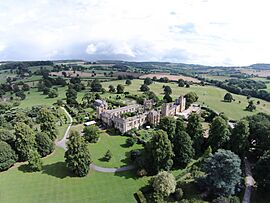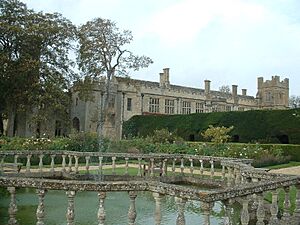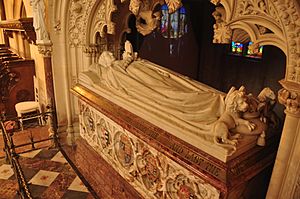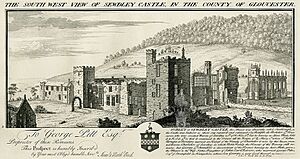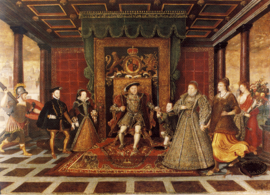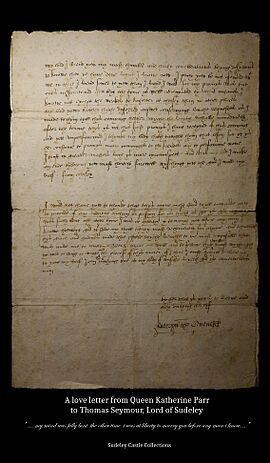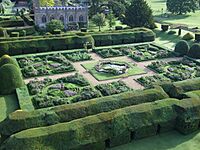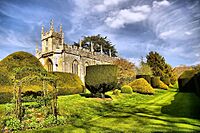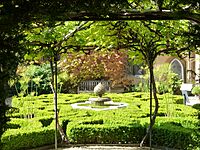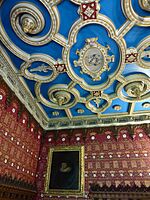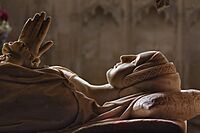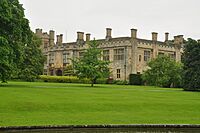Sudeley Castle facts for kids
Quick facts for kids Sudeley Castle |
|
|---|---|
| Winchcombe, Gloucestershire in England | |
|
Aerial view of Sudeley Castle
|
|
| Coordinates | 51°56′50″N 1°57′22″W / 51.94722°N 1.95611°W |
| Type | Visitor Attraction, Wedding Venue and Private Residence |
| Area | 1,200 acres |
| Site information | |
| Owner |
|
| Open to the public |
Seasonally |
| Status | Intact |
| Site history | |
| Built | 1443 on the site of a previous fortified manor house |
| Built by |
|
|
Listed Building – Grade I
|
|
| Official name | Sudeley Castle |
| Designated | 4 July 1960 |
| Reference no. | 1154791 |
| Official name | Sudeley Castle |
| Designated | 28 February 1986 |
| Reference no. | 1000784 |
| Battles/wars |
|
Sudeley Castle is a beautiful historic castle located in the Cotswolds hills, near Winchcombe, Gloucestershire, England. It's a very special place because it's the only privately owned castle in the world where an English Queen is buried! The castle has 10 amazing gardens that cover about 15 acres, all within a huge 1,200-acre estate.
The building of Sudeley Castle started in 1443. It was built for Ralph Boteler, who was a very important person called the Lord High Treasurer of England. His castle was built on the site of an older fortified house from the 12th century. Later, the castle was taken by the King and became the property of King Edward IV and King Richard III. Richard III even built a famous banqueting hall there.
King Henry VIII and his wife Anne Boleyn visited Sudeley in 1535. Later, it became the home and final resting place of Henry VIII's sixth wife, Catherine Parr. She remarried after the King's death and is buried in the castle's church. Sudeley then became home to the Chandos family. Queen Elizabeth I visited the castle three times, even holding a big three-day party there to celebrate a victory against the Spanish Armada.
During the First English Civil War, Sudeley Castle was used as a military base by King Charles I and Prince Rupert. It was later attacked and partly destroyed by Parliament's forces. The castle remained mostly in ruins for a long time until the Dent family bought it in 1837. They restored the castle and made it a family home once more.
Contents
Exploring Sudeley Castle's Past
Early Beginnings: The 11th and 12th Centuries
The story of Sudeley Castle goes back a very long time. Its name, Sudeleagh, is an old Anglo-Saxon word meaning 'south-lying pasture'. This gives us a clue about what the area was like long ago. Sudeley became an important royal estate because it was close to Winchcombe. Winchcombe was once the capital of the Kingdom of Mercia, a powerful Anglo-Saxon kingdom.
By the early 11th century, Sudeley was a manor house with a royal deer park. King Æthelred the Unready gave it as a gift to his daughter, Goda, on her wedding day. Even after William the Conqueror took over England in 1066, Goda's family managed to keep Sudeley for another 400 years.
In the 12th century, during a time of civil war called The Anarchy, John de Sudeley supported Empress Matilda in her fight for the throne. It's thought that the first castle at Sudeley was built around this time. It might have been a new building or just the existing manor house made stronger. However, after some battles, the castle's defenses were likely pulled down.
A few decades later, John's younger son, William de Tracy, was involved in the murder of Thomas Becket, a famous Archbishop. William was punished by the Pope and sent away to Jerusalem.
Building the Castle We See Today
By the 15th century, the Boteler family inherited Sudeley. Ralph Boteler began building the current castle in 1443. He was a very important person in King Henry VI's government. Ralph built Sudeley Castle with two courtyards. The outer courtyard was for servants and soldiers, while the inner court was for Ralph and his family.
In 1449, Ralph's son, Thomas Boteler, married Lady Eleanor Talbot. She was known as 'England's Secret Queen' because of her relationship with King Edward IV. This relationship was later used by King Richard III to claim the throne for himself.
King Richard III's Time at Sudeley
Ralph Boteler lost favor with the new king, and in 1469, he had to sell Sudeley to the crown. King Edward IV gave Sudeley to his brother, Richard, Duke of Gloucester. Richard used it as a military base before an important battle in 1471.
When Richard became King Richard III in 1483, Sudeley became his property again. He is famous for building the large banqueting hall at Sudeley. This "Great Hall" was very modern for its time. It had a ground floor for guests and a special upper hall for the King and his important visitors. The hall's windows were decorated with the White Rose of York, a symbol of his family.
Today, the banqueting hall is partly in ruins and has been turned into a beautiful garden with roses and ivy. After Richard III died in battle in 1485, Sudeley went to King Henry VII, who then gave it to his uncle, Jasper Tudor.
Queen Catherine Parr's Home
King Henry VIII only stayed at Sudeley once, in 1535, with Anne Boleyn. After Henry VIII died, his last wife, Catherine Parr, secretly married Thomas Seymour. This caused a small scandal because they didn't get permission from the new young king, Edward VI.
In 1548, Catherine, who was pregnant, moved to Sudeley Castle with Thomas. They brought a large group of people with them, including 120 guards and many ladies-in-waiting. Thomas had spent a lot of money to make the castle fit for a Queen. One of Catherine's attendants at Sudeley was Lady Jane Grey, who would later be queen for just nine days.
Catherine Parr died at Sudeley on September 5, 1548, shortly after giving birth to her daughter. She was buried two days later at St. Mary's Church, which is on the castle grounds. This was the first Protestant funeral in England. Over the years, her original tomb was damaged, and its location was lost. In 1782, her coffin was found.
After the chapel was restored in 1863, Catherine Parr's remains were placed in a new, beautiful tomb. Today, her tomb is a special place that many people visit. After Catherine's death, Thomas Seymour kept Sudeley until he was executed for treason. The castle then went to Catherine's brother, William Parr, but it was later taken by the crown.
The Chandos Family and Queen Elizabeth I
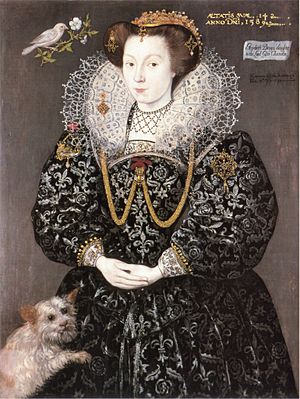
In 1554, John Brydges became Baron Chandos of Sudeley. His son, Edmund Brydges, made many changes to the castle in the 1560s and 1570s, rebuilding much of the outer courtyard.
Queen Elizabeth I visited Sudeley three times during her reign. Her most famous visit was in 1592, when Giles Brydges, the 3rd Baron Chandos, threw a huge three-day party for her. Giles prepared the castle grounds beautifully for the visit. There were banquets, plays, dances, and amazing gifts. This visit was so grand that it almost made the Brydges family go broke!
Archaeologists have been working at Sudeley since 2018. They are discovering more about these old gardens and how they were designed for Queen Elizabeth's visit.
Sudeley During the English Civil War

Under the Chandos family, Sudeley continued to be a grand place. Grey Brydges, the 5th Baron Chandos, was even called the "King of the Cotswolds" because of his fancy lifestyle and generosity.
Sudeley's last royal visitor was King Charles I during the English Civil War. This war was fought between the King and Parliament. The new lord, George Brydges, supported the King. In January 1643, Parliament's soldiers attacked the castle. The small group of defenders soon gave up, and the castle was robbed.
Later that year, King Charles I used Sudeley as his base in Gloucestershire. The castle changed hands several times during the war. In 1649, after the war ended, Parliament ordered the castle to be partly destroyed. This was to make sure it could never be used as a military base again. The inner courtyard and royal rooms were mostly taken apart, but much of the outer courtyard was left standing.
George Brydges, the lord, was in debt and couldn't rebuild Sudeley. He died in 1655, and the castle was left as a neglected ruin for almost 200 years.
The Victorian Restoration of Sudeley
For nearly two centuries, Sudeley Castle was mostly in ruins, but it was never completely empty. In 1837, two wealthy brothers, John and William Dent, bought Sudeley Castle. They made their money making gloves. When they bought it, the castle was "ruined, but partly occupied by tenants." One tenant had even turned part of the castle into a pub and was selling off its stones!
The Dent brothers carefully restored the castle. They decided not to rebuild everything, leaving some parts as beautiful ruins. This gives the castle its special look today. They also filled the castle with amazing art and antiques.
By 1855, the brothers had passed away, and the castle was inherited by their nephew, John Croucher Dent, and his wife, Emma Dent. Emma was from a wealthy silk manufacturing family. She worked to improve the castle and add to its collections.
Emma loved to entertain, hosting many parties and guests. She also wrote many letters, including some from Florence Nightingale. In 1859, Emma started to recreate a historic garden. She also made the house bigger and improved its services.
Later, Henry Dent Brocklehurst and his wife Marion inherited the castle and redecorated it. Their son, Jack, made more changes, including creating a beautiful library. His wife Mary brought a wonderful collection of paintings to the castle.
Sudeley in Modern Times
By the start of World War II, Sudeley was facing financial difficulties. During the war, the castle was used to store art from the Tate Gallery to keep it safe from bombings.
A prisoner of war (POW) camp for Italian and German soldiers was located where the visitor car park is today. The POWs worked on local farms until the camp closed in 1948.
Elizabeth, Lady Ashcombe, first came to Sudeley after marrying Mark Dent-Brocklehurst in 1962. They decided to open the castle to the public, which they did in May 1970. Mark passed away in 1972, and Elizabeth continued to manage Sudeley.
In 1979, Elizabeth (now Lady Ashcombe) and her children, Henry and Mollie Dent-Brocklehurst, took over managing the castle as a visitor attraction. They have worked hard to restore and preserve Sudeley.
In 2018, the castle's exhibitions were redesigned and reopened as "Royal Sudeley 1,000: Trials, Triumphs and Treasures." This exhibition takes visitors through 1,000 years of Sudeley's history, showing important artifacts and artwork.
Sudeley Castle opens to the public during certain seasons. While it's a popular tourist spot and a wedding venue, it's also still a family home. Elizabeth, Lady Ashcombe, is often called the "chatelaine" (the lady of the castle) of Sudeley.
In September 2019, thieves stole items from the castle's royal exhibition. These included rare keepsakes given by King Edward VII to a special person.
Gardens and Parkland at Sudeley
Sudeley Castle is located in the middle of a large 1,200-acre estate in the Cotswold valleys. The estate has open fields and woodlands. Many public walking paths cross the estate, including the Cotswold Way, a long-distance footpath. These paths connect Sudeley to other historic places like Hailes Abbey and Belas Knap.
The castle gardens cover about 15 acres and are open to visitors during the castle's open season.
The garden is divided into ten different sections. The most important one is the Queens' Garden. This garden is a Victorian recreation of an original Elizabethan garden. The large yew hedges around it date back to 1860. Today, the Queens' Garden is home to over 80 different types of roses.
Another garden at Sudeley is The Knot Garden. It's made up of more than 1,200 box hedges. Its detailed design was inspired by the pattern on a dress worn by Queen Elizabeth I in a painting that hangs in the castle.
St Mary's Church, where Catherine Parr is buried, is surrounded by the White Garden. This garden has beautiful white flowers like peonies, clematis, roses, and tulips. Catherine and her friend, Lady Jane Grey, would have walked through this garden to enter the church for daily prayers.
Sudeley is also home to one of the world's largest public collections of endangered pheasants. The pheasantry has been at the castle for over 30 years. It's part of a program to help increase the numbers of critically endangered birds and hopefully reintroduce them into their natural homes.
Visiting Sudeley Castle
Sudeley Castle has been a tourist attraction since the early 18th century. Many artists and people interested in history visited it. King George III even visited in 1788.
Today, Sudeley is one of the few castles in England that is still a private home. The Dent-Brocklehurst family works hard to make the castle and gardens open to the public during certain seasons. However, the family's private living areas usually remain closed to visitors.
Art Collection at Sudeley
The main part of Sudeley's art collection came from a huge auction in 1842. This auction sold off the art collection of Horace Walpole, who was the son of Robert Walpole, often called the first Prime Minister of Great Britain. More art was added over the years, including pieces from the collection of Victorian businessman James Morrison.
The castle's collection isn't just paintings. It also includes amazing historical items like a prayer book and a love letter belonging to Catherine Parr, old weapons, and a very rare book called the Bohun Book of Hours.
Not all the art is always on display. Some pieces are kept in the family's private rooms. However, the castle sometimes offers special art tours that take small groups to see these private collections.
Here are some of the famous artworks at Sudeley Castle:
- An Allegory of the Tudor Succession: This painting was ordered by Queen Elizabeth I for her spymaster, Sir Francis Walsingham.
- Rise of the River Stour at Stourhead by J. M. W. Turner: A famous painting from 1817.
- A Portrait of Peter Paul Rubens by Anthony van Dyck: A painting of a famous artist by another famous artist.
- Flora by Bernardino Luini: Painted around 1515.
- Miniature of King Henry VIII by Lucas Horenbout: A tiny, detailed portrait of the King.
- Miniature of Queen Catherine Parr by Hans Holbein the Younger: A tiny portrait of the Queen.
Textile Collection
Sudeley Castle has an amazing collection of textiles, put together by Emma Dent in the 19th century. It's considered one of the best collections in the country. Because some pieces are very delicate, only a few are on display in the castle's exhibitions. The rest are kept safely stored away.
Here are some highlights from the textile collection:
- Louis XV Aubusson bed hangings: Thought to have belonged to Marie Antoinette.
- The Sudeley Stumpwork Box: A beautiful embroidered box from around 1660.
- A waistcoat: Believed to have belonged to King Charles I.
- A 16th-century lace canopy: Said to have been made by Anne Boleyn for the christening of Elizabeth I.
- A piece of cloth: Said to be from Catherine Parr's dress, found when her tomb was rediscovered in 1782.
- Early 17th-century Sheldon Tapestry: Woven with wool, silk, and metal threads, showing flowers and Bible scenes.
Gallery
See also


